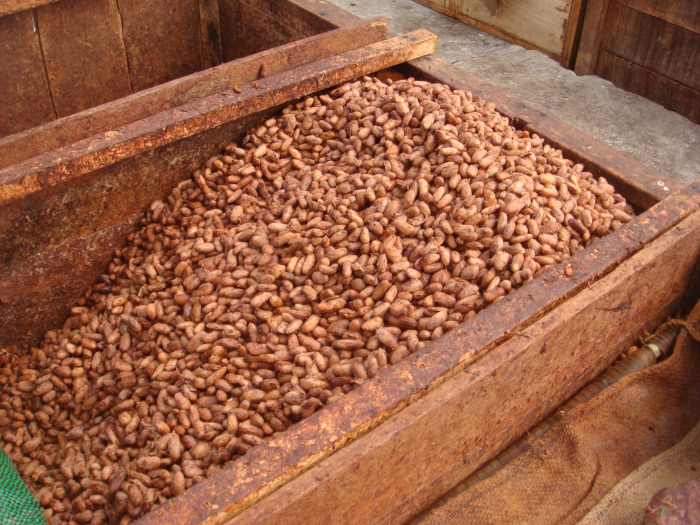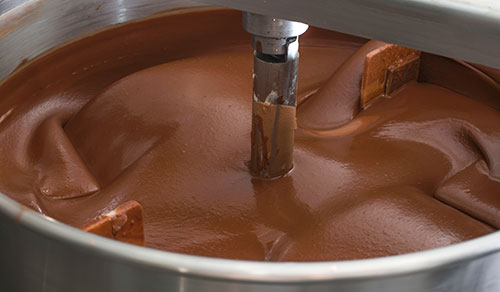If you were born in the 1970s or later, chances are you grew up watching either Willy Wonka and the Chocolate Factory starring Gene Wilder or, in the case of much of my generation, Charlie and the Chocolate Factory starring Johnny Depp. Regardless of which film you grew up with you were sure to be inspired by the fantastic things in the chocolate factory from the impish oompa-loompas to magical forbidden treats and wild punishments for naughty children. However, one secret of the chocolate factory is never told. How exactly do the Oompa-Loompa’s make the delicious chocolate Wonka Bars which contain the Golden Ticket?
The whole chocolate making process starts out with the Theobroma cacao tree, which is native to the tropical regions of Central and South America. Little fruits called pods grow, are harvested and cracked open. The cocoa beans they contain, which are the Oompa-Loompa’s payment and favorite food, are used to make chocolate.
The next step is a little less magical but a little more scientific: fermentation. According to the International Cocoa Organization, fermentation takes place in huge wooden crates holding one or two tonnes of cocoa beans. Inside of these boxes Drosophila melanogaster (more commonly known as the fruit fly) contaminate the beans with microorganisms. While these bugs are typically considered pests, they are vital to the fermentation process. Once the beans are exposed to microorganisms yeast begins to grow on the surrounding pulp. The yeast then converts the sugars in the pulp to ethanol. Bacteria begins to oxygenize the ethanol, which first becomes acetic acid, and then carbon dioxide and water. This produces heat and banana leaves are often used to cover the beans, in order to maintain that heat.
On the second day the pulp begins to liquefy. Because of this the boxes must allow for the disposal of liquified pulp over time. Lactic acid is produced, which would convert alcohol in anaerobic conditions, however the remaining acetic acid oxidizes the alcohol, turning it into acetic acid. The crates often have shallow levels of beans, to allow for aeration and aid this process. During this period the temperature rises from 40 degrees celsius to 45 degrees celsius. The heightened temperature and acetic acid eventually kills the coffee bean, and when the coffee bean is killed the cell wall to breaks down.
Throughout the remaining fermentation period, which differs depending on the type of bean and fermentation facility, chemical reactions take place. These reactions include the proteins oxygenizing and breaking down to become amino acids. During this part of the process beans are usually shifted around to increase aeration and bacterial activity. The boxes are often tiered, so that it’s easy to transfer beans between boxes each day for uniform fermentation.
The newly fermented beans are dried and cleaned to remove any leftover dirt or debris. The next step is called winnowing, in which the cotyledon, also known as the nib, is removed from the shell. The nib is then roasted to further develop its flavor. After it’s roasted, the nibs are ground, milled and typically liquified, making chocolate liquor, which can later be separated into separate the cocoa from the cocoa butter.
It is during this step that the familiar “chocolate bar” (aka Wonka Bar) begins to take form. Milk chocolate is made by blending milk products with sugar, which is then mixed with chocolate liquor and cocoa powder. That mixture drys into a crumbly powder.
The next step is called conching, which is the process of slowly mixing and heating the remaining ingredients, which helps develop the flavor and texture of the chocolate. In the case of milk chocolate this means making it smooth and sweet. The mix is then poured to into the mould to make a chocolate bar.
While we do not know the specifics of everything that’s made at Willy Wonka’s Chocolate Factory, I think it is safe to assume that other chocolaty treats are also produced. For example, if the Oompa-Loompa’s make hot cocoa powder, in the Dutch style, they would do so by putting chocolate liquor into a giant hydraulic press where roughly half of the cocoa butter is removed. What remains is called “press cake” which baking soda is added to. After the baking soda is added the product is cooled down, broken down to a grainy texture, and sifted until it becomes the powdery goodness you buy at the grocery store and mix with heated milk.
So, what’s done with all of the extra cocoa butter? Cocoa butter is put in a number of products from lotion to pharmaceuticals. While I like smooth skin and all, my personal favorite use for cocoa butter is when it’s made into white chocolate. To make white chocolate manufacturers mix cocoa butter, milk, sugar and other sweeteners- most often vanilla. Because it does not actually contain cocoa solids, there’s much debate as to whether or not it is actually chocolate. While sources like Live Science claim that this lack of cocoa solids means that white chocolate isn’t chocolate, I’m fairly certain that Wonka’s consumers enjoy the sweet treat.
So next time you watch Willy Wonka and the Chocolate Factory or Charlie and the Chocolate Factory, while you’re being enthralled in the magic of the chocolate factory, you will also know all the work that the Oompa-Loompa’s went to in order to making those Wonka bars which contained golden tickets for 5 lucky, or possibly 1 lucky and 4 unlucky, children. I don’t know about you, but I don’t think I would do all that just for cocoa beans!
Abby Bainbridge is studying Journalism with a concentration in Public Relations,
as a member IU’s class of 2021. She is a writing and content intern in the marketing department at WonderLab Museum of Science, Health, and Technology.
As a lover of both chocolate and science she is excited for WonderLab After Dark: Chocolate on Saturday February 17.




Leave A Comment